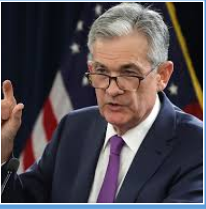På sit virtuelle strategimøde i går slog den amerikanske centralbank fast med syvtommersøm, at der ikke bliver nogen rentestigning i meget lang tid, og at centralbanken med sindsro vil lade inflationen stige til et gennemsnitligt niveau på 2 pct. ING mener, at det kan få de lange renter til at stige en smule. ING vurderer, at det sammenlagt er den bedst tænkelige politik for at stimulere beskæftigelsen.
Fed: We really, really, really aren’t going to raise rates soon…
Fed Chair Jerome Powell’s speech and the accompanying FOMC statement show a formal adoption of “average” inflation targeting. Their new language gives them the flexibility to let the economy run a little hotter before contemplating raising interest rates and gives the green light to more modest yield curve steepening and dollar weakness
Average inflation targeting formally adopted
Jerome Powell’s speech at the virtual Jackson Hole Symposium tells us that the Fed have decided on a formal adoption of “average inflation targeting”, which obviously allows inflation to rise above 2% “for some time” to compensate for periods when it has undershot.
In their Review of Monetary Policy, the Fed have been motivated by their assessment that the “new normal” for the US economy has changed.
‘New normal’ for the US economy has changed
Firstly, their estimate for long-run US growth rates have declined due to weaker productivity and an ageing population. Secondly, estimates for the neutral interest rates (where growth is at trend and inflation is stable) have also declined while their third belief is that rising labour market participation rates allow economic benefits of growth to be more widely felt.
Then fourthly the point at which declines in the unemployment rate start to generate inflation has fallen over recent years and this limits the scope for a meaningful pick-up in inflation over the medium to longer term.
New language = even more flexibility
Taking these points together they argue that this all has a depressing effect on inflation over the medium term and that we must acknowledge inflation staying persistently below target is just as bad is it remaining above target. The consequence is that an “average” of 2% “over time” is a better aspiration to have.
Inflation that is too low can bring an “unwelcome fall in longer-term inflation expectations, which, in turn, can pull actual inflation even lower, resulting in an adverse cycle of ever-lower inflation and inflation expectations”. This must be avoided as it can lead to lower market interest rates, which in turn would give the Fed “less scope to cut interest rates to boost employment during an economic downturn”.
With regard to their assessment of their employment goal, it will be informed by “assessments of the shortfalls of employment from its maximum level” rather than by “deviations from its maximum level” as in our previous statement”.
They argue that “this change may appear subtle, but it reflects our view that a robust job market can be sustained without causing an outbreak of inflation”.
Our interpretation is that “deviation” implies focusing on both upside and downside, whereas “shortfalls” is much more of a one sided focus – again it implies the Fed has a more relaxed approach and is tolerating the economy running a little hotter before contemplating raising rates.
Lower for longer, but we knew that anyway
The Fed believe that this “robust” update of language can give the market, businesses and consumers confidence that the Fed will be seeking to achieve 2% inflation over time.
In reality, it just gives the Fed even greater flexibility. They admit that they “are not tying ourselves to a particular mathematical formula that defines the average”, so we don’t know a start or an end point, and then they say they “appropriate monetary policy will continue to reflect a broad array of considerations”.
All very vague stuff, but the message is clear – rates are not rising anytime soon.
To be fair we already knew that given the Fed’s “dot plot” of individual member forecasts has already suggested just two members expect rates to be raised before the beginning of 2023 the market impact is limited.
It will merely reinforce the message that the Fed really, really, really won’t be raising rates imminently, thereby anchoring the short end of the curve even more sturdily.
What it means for the bond market
The impact effect of Powell’s statement on market rates was to test lower, indicating that market positioning pre-Powell was biased towards an upward test in rates. And an upside test makes complete sense; a move to average inflation implies that the back end is less protected, as the Fed would have a tolerance to seeing inflation moving to above 2% to compensate for prior experiences below.
The subsequent price action began to price this realization as the 30yr shot back above 1.4%. All things considered this seem to us to be the most sensible outcome – upward pressure on ultra-long rates.
On the front end it is a different story. The fact that the Fed is prepared to hold off on hikes even as inflation edges above 2% by definition means that the front end is lower for longer. In consequence the initial flattening response was reversed to result in a net steepening of the curve, which again is a reaction that makes some sense.
Net effect has been to leave inflation expectations moderately lower
Interestingly, the net effect of Powel’s statement so far has been to leave inflation expectations moderately lower. However, we suspect this will be a short-term thing. The more logical outcome is a moderate uptick in inflation expectations.
The prognosis ahead is for long-dated market rates to have a green light to test moderately higher from here.
The approach of say big-figure 1% for the 10yr is still quite a jump from here in the 70bp area; we’d still see any uplift in yields fading on any approach of the recent June high in the 90bp area. And by definition any re-steepening and re-approach of that level offers opportunity to go the other way and set receivers and re-flatteners.
Tactically though, curve steepening from the back end and inflation breakeven longs are the way to go in the immediate aftermath of Powell.
The dollar impact
FX markets reacted to the speech by initially taking the dollar around 0.5/0.6% lower. The speech largely delivered on market expectations of Average Inflation Targeting and greater tolerance of lower unemployment.
Bearish overhang for the dollar should be maintained
Assuming that policymakers can keep ‘V’ shape recovery hopes alive – and inflation expectations firming – the market will probably run with this theme into 2021. This should maintain the bearish overhang for the dollar and be an important support for portfolio flows into emerging markets.










